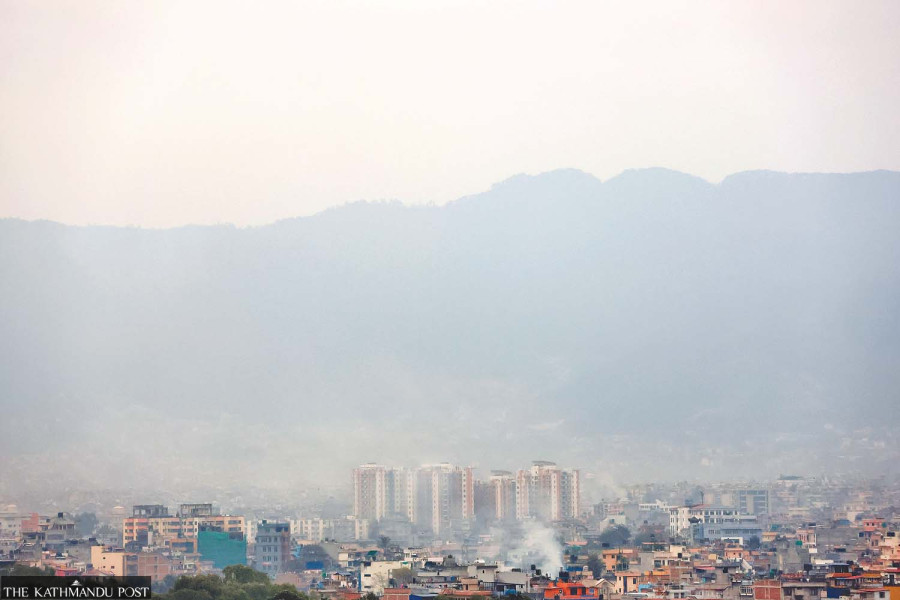Health
As air in Kathmandu Valley deteriorates to hazardous level, patients of respiratory illness rise
A low-pressure system formed in the west caused cloudy conditions throughout the country on Wednesday.
Arjun Poudel
Air quality in the Kathmandu valley deteriorated further on Wednesday reaching a ‘hazardous level’, crossing the 300 mark, that raised concern about respiratory conditions, especially among children and elderly people.
According to IQAIR, a Swiss group that collects real-time air-quality data from around the globe, particulate matter pollution (PM2.5) levels of Sallaghari Bhaktapur reached 305 micrograms per cubic metre by 10:45 am.
PM2.5 refers to particulate matter or solid and liquid droplets in the air that are less than 2.5 micrometres, or 400th of a millimetre, in diameter.
As per the United States Environment Protection Agency’s air quality index, when air pollutant PM2.5 exceeds 300 μg/m3, the level is considered ‘hazardous’ for everyone and may prompt emergency condition alerts.
The Kathmandu Valley’s Air Pollution Management Action Plan provides that the authorities can declare a public health emergency whenever AQI readings exceed 300. However, none of the agencies concerned has considered declaring a public health emergency to mitigate the impact of air pollution.
“We have deployed 300 cleaning staffers, who have been removing dust from the streets of the metropolis,” said Rabin Man Shrestha, chief of the environment department at the Kathmandu Metropolitan City. “We have also been spraying water to lessen the dust pollution.”
The air quality monitoring station at Nagarjun recorded particulate matter pollution (PM2.5) levels 228 micrograms per cubic metre, which is a very unhealthy level. When air pollutant PM2.5 reaches 201 to 300 μg/m3, air quality is considered very unhealthy; everyone may experience problems, with sensitive groups experiencing more severe effects.
Likewise, several other places in the Valley having air-quality monitoring stations recorded deterioration in the air quality.
Doctors suggest people of risk groups, including children, pregnant women, elderly and those with respiratory illnesses, avoid all outdoor activities.
“Even healthy and young people could suffer from respiratory problems when air quality deteriorates to hazardous levels,” said Dr Raju Pangeni, a pulmonologist. “People should avoid outdoor activities if the air quality levels remain hazardous.”
Doctors say air pollution is known to cause various respiratory illnesses. Poor air quality can cause short- and long-term effects on public health. Bad air quality can lead to pneumonia, bronchitis, conjunctivitis, skin allergy, stroke, and heart problems in the short term, and ulcers and cancer of the lungs and intestine, kidney disease, and heart problems in the long run.
Doctors advise people to avoid highly polluted places and stay home. They say that recovery from infections of other viruses also slows down when the air quality deteriorates.
“Every day I encounter at least one patient, whose entire family has been infected with viral infections,” said Pangeni. “Young people are getting infected with viral infections and elderly people from their family are getting hospitalised.”
Experts advise people to avoid exposure to pollution and wear face masks while going out.
Meanwhile, the Meteorological Forecasting Division of the Department of Hydrology and Meteorology said that a low-pressure system formed in the west caused cloudy conditions throughout the country on Wednesday.
“Weather has been clear in most places of Sudurpaschim, Karnali and Gandaki provinces,” said Raju Pradhananga, a senior divisional meteorologist at the division. “Some places of Koshi and Madhesh provinces witnessed light rainfall. The weather will clear from Thursday.”
Pradhananga said there is no weather system in sight that would cause rainfall in the Kathmandu valley.
The country has not witnessed heavy rainfall since October last year. Experts blamed the lack of rainfall for a long time for the worsening air quality in the Valley.




 7.12°C Kathmandu
7.12°C Kathmandu














